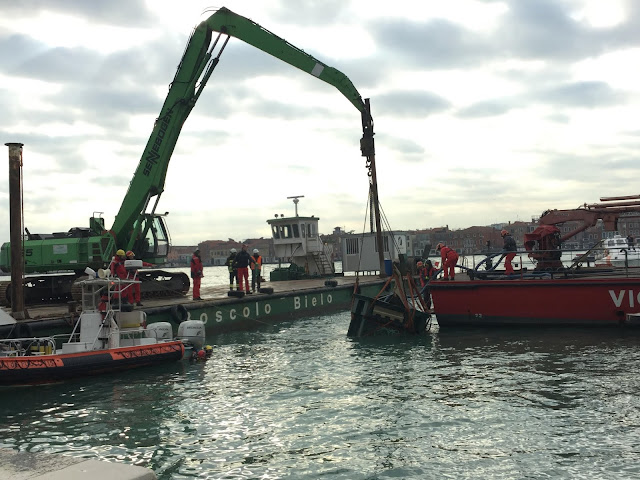 |
| Madonna della Salute 2020 - Photo: Cat Bauer |
(Venice, Italy) No blazing candles. No pontoon bridge. No balloons for the children, or sweets from the South of Italy. We can only imagine the discussions that went on as to how to celebrate the Feast of the Madonna della Salute this November 21st -- the day when Venice gives thanks for deliverance from the plague -- in a year restricted by a global pandemic.
Normally, thousands of Venetians pour across a pontoon bridge that stretches across the Grand Canal from the Gritti Palace over to the Dorosoduro side. This year, pedestrian traffic was steered in a one-way direction through the Dorsoduro Museum Mile until you arrived in the Campo della Salute. Along the way, you could buy votive candles as usual -- but this year the eager masses waiting to have their wicks set ablaze inside the church was restricted. Instead, upon reaching the campo, you got in line and waited to enter through the front door of the church. The line moved quickly enough, and everyone was respectful. It goes without saying that everybody was required to wear masks indoors and out -- that is a rule throughout Italy.
Once inside, you placed your candles in wooden boxes scattered throughout the interior of the church "as a votive gift that will become a work of charity and support for families in economic difficulty." The magnificent rose mosaic was cordoned off, so I got my annual Beam-Me-Up-Scotty power charge not by standing in the center, but from a short distance away.
 |
| Church of Madonna della Salute on Nov. 21, 2020 - Photo: Cat Bauer |
In 1630, Venice was raging with the plague, which, we now know, was caused by a bacteria, as opposed to COVID-19, which is caused by a virus. On October 22, 1630, the Venetian Senate decreed that in order to give thanks for the liberation of Venice from the plague that had wiped out a third of the population, they would build a church dedicated to the Virgin Mary, under whose protection Venice was founded on the Feast of the Annunciation, March 25, 421.
Once inside, you could sit in the pews to pray, which I did. I contemplated the
high altar, which was designed by Baldassare Longhena, as was the Church
of Madonna della Salute itself. The impressive marble statues were carved by the
Flemish sculptor, Josse de Corte.
What fascinates me about the 17th-century high altar is that the females are the ones enacting the scene, and the males, Saint Mark, Venice's patron saint, and Saint Lorenzo Giustiniani, who was the first Patriarch of Venice, are only onlookers to the drama going on over their heads.
In the center of the altar stands the Virgin, holding the infant Christ, surrounded by cherubs. To her right, Venice, in the form of a beautiful young woman, is on her knees, pleading for help. To the left of the Virgin is a gruesome old woman, who represents the plague. A torch held by a cherub burns into the old woman's side; her arms flail as she teeters towards the edge. The Virgin does not even glance at the old woman. The expression on the Virgin's face is one of quiet confidence that the black death will be vanquished. The entire scene is supported by caryatid angels, which are sculptured female figures used as columns.
Below the Virgin, in the center of the altar, is the star of the show, the Byzantine Black Madonna, whose powerful energy has attracted the faithful for centuries. The Panagia Mesopantitisa -- Madonna the Mediator -- was brought to Venice from Crete by Doge Francesco Morosini after the War of Candia with the Ottoman Turks.
Despite the restricted nature of the celebration this year, the spiritual elements were firmly in place. They say that Longhena's design of the church may have been inspired by a woodcutting in the mysterious Renaissance book Hypnerotomachia Poliphili. To me, simply entering the Church of the Madonna della Salute and communing with the Panagia Mesopantitisa is enough to boost one's immune system for another year.
The only element I really missed was the lighting of the candles, so afterwards I went to the Church of Santo Stefano, where Francesco Morosini is buried, and lit a candle in front of the Madonna there.
I've written about the Feast of the Madonna della Salute many times before. My post from 2013 will give you an idea what the celebration is like in normal times:
Wishing everyone good health, vitality and compassion.
Ciao from Venezia,
Cat Bauer










